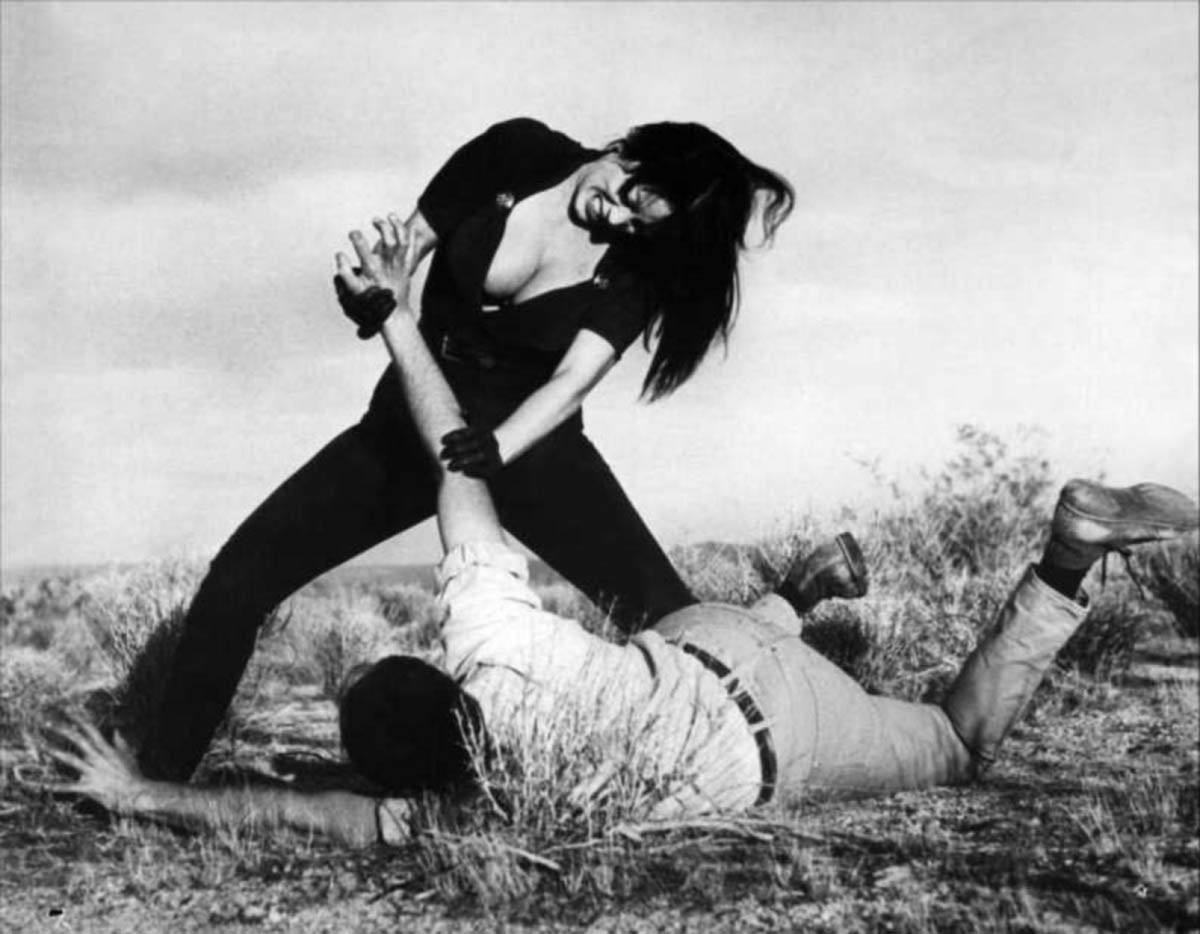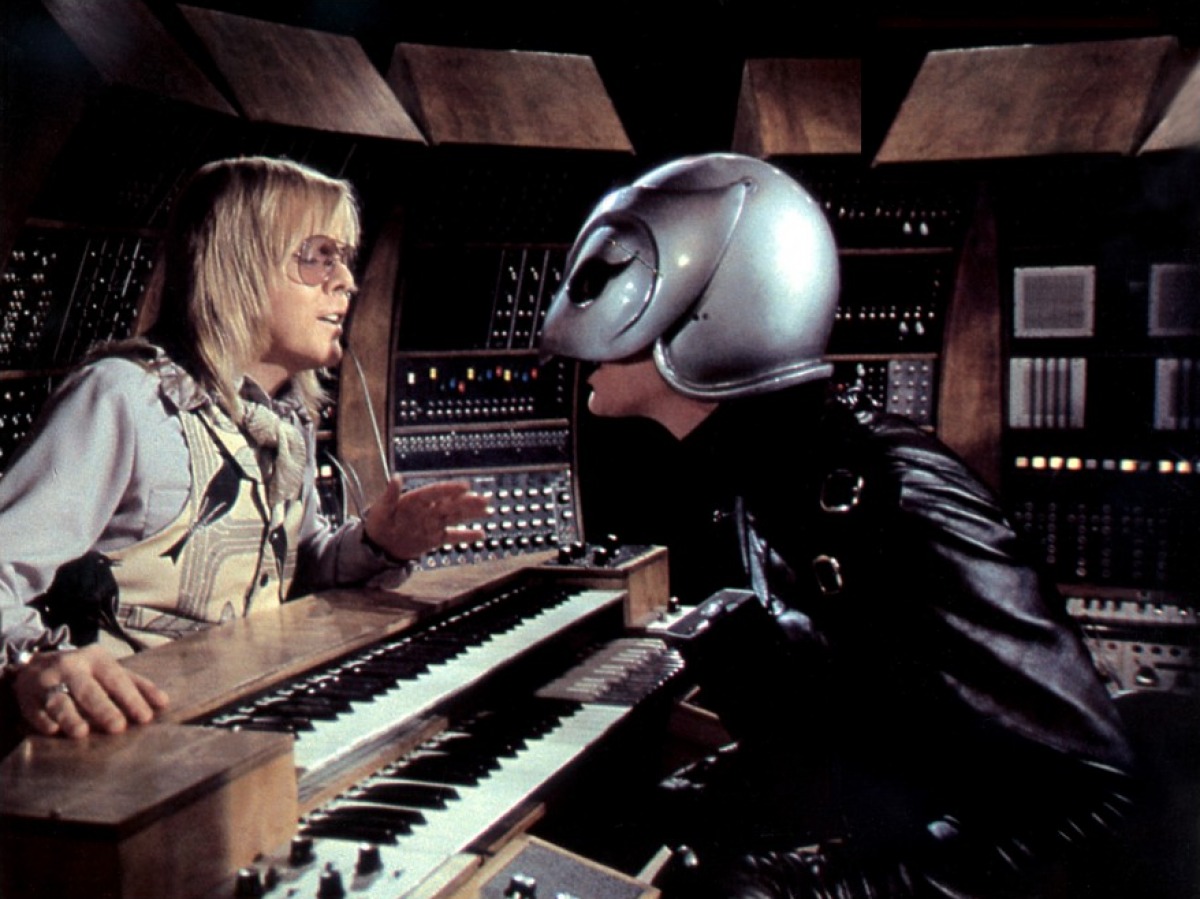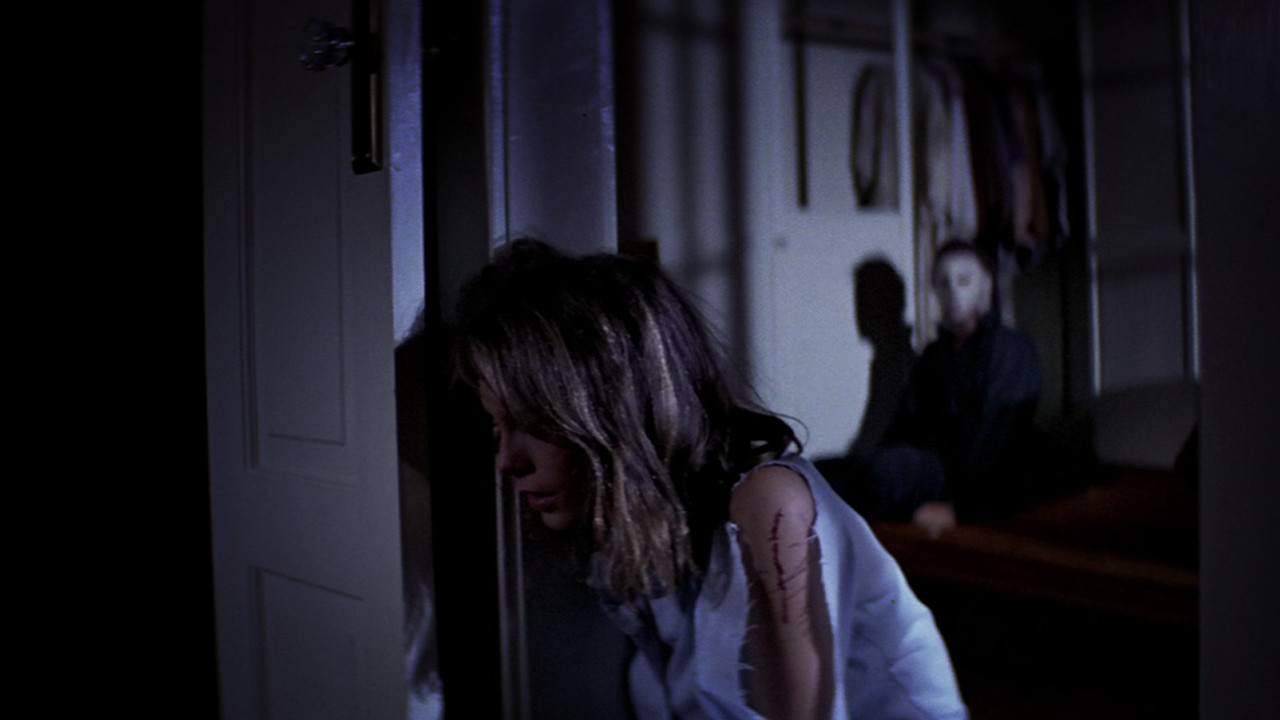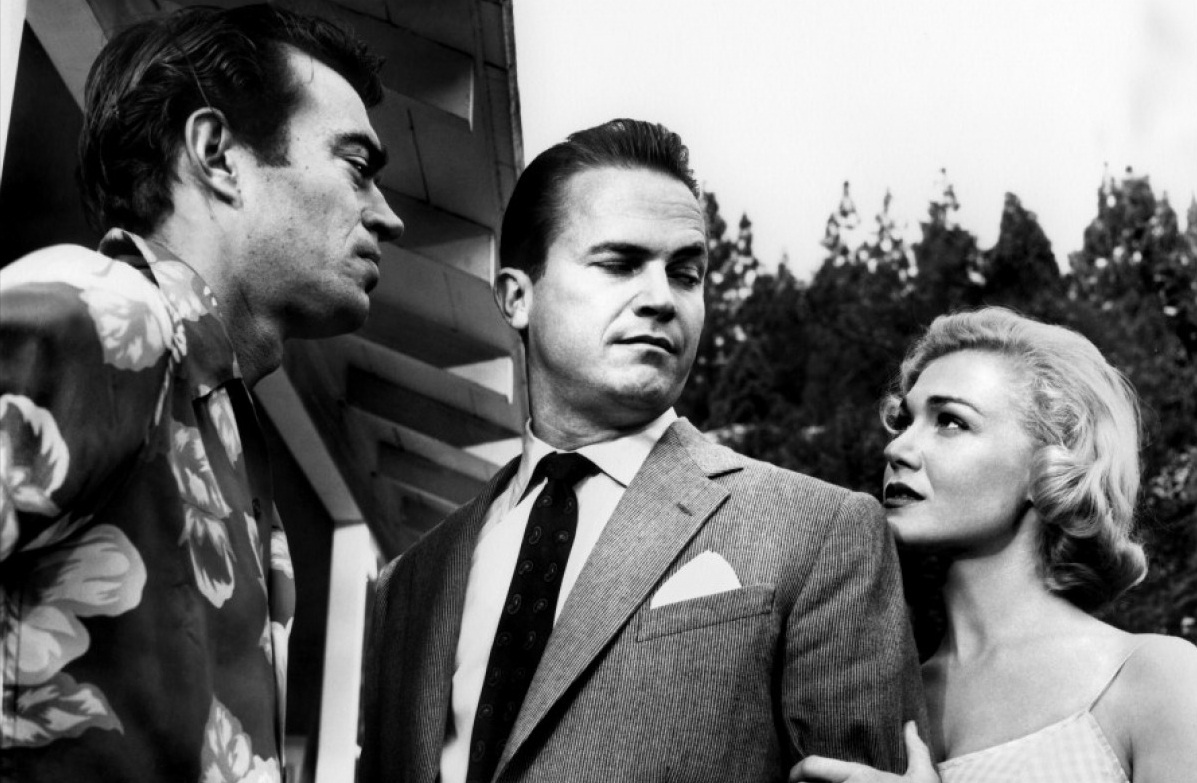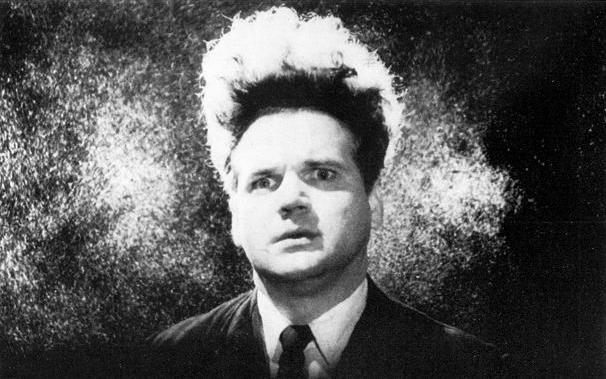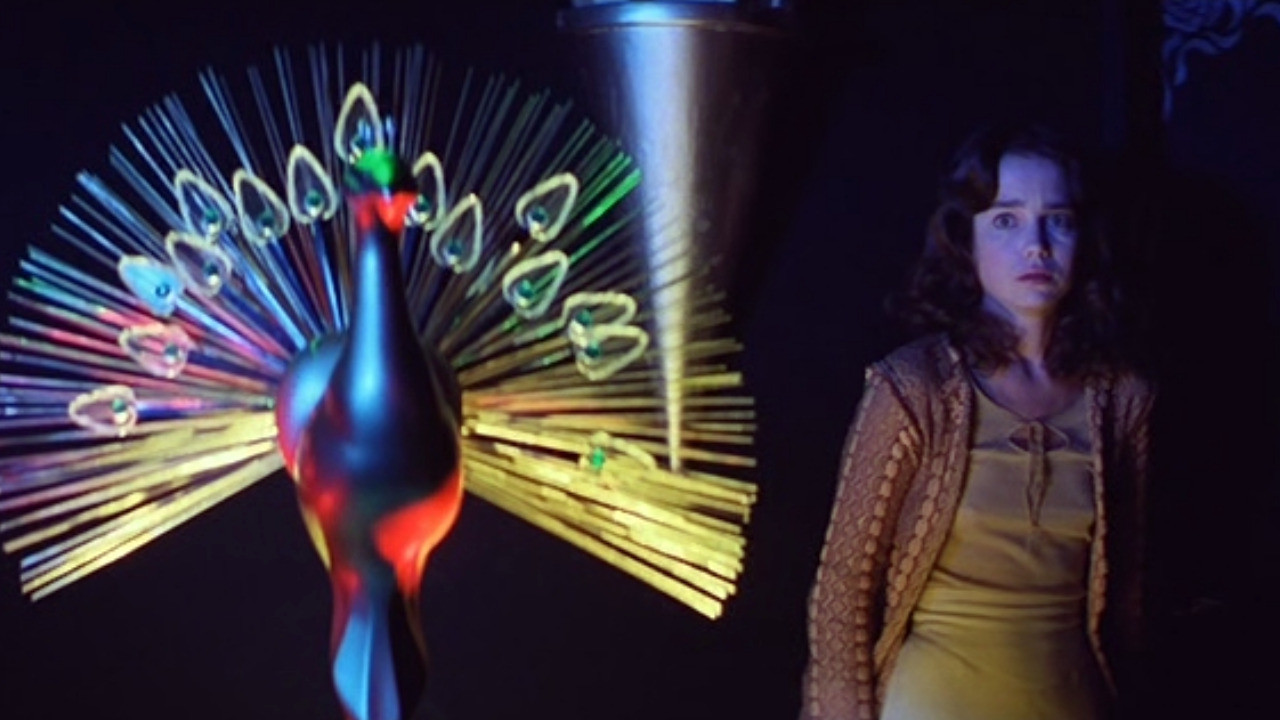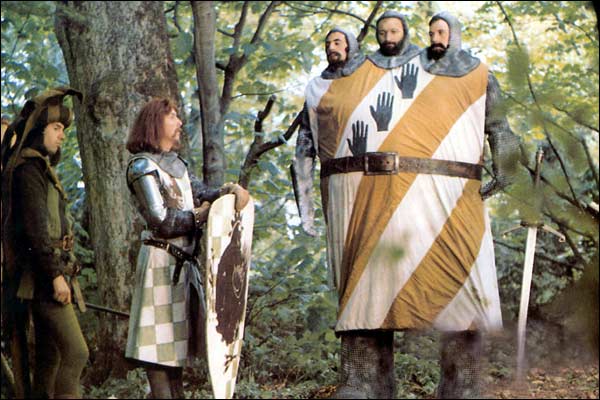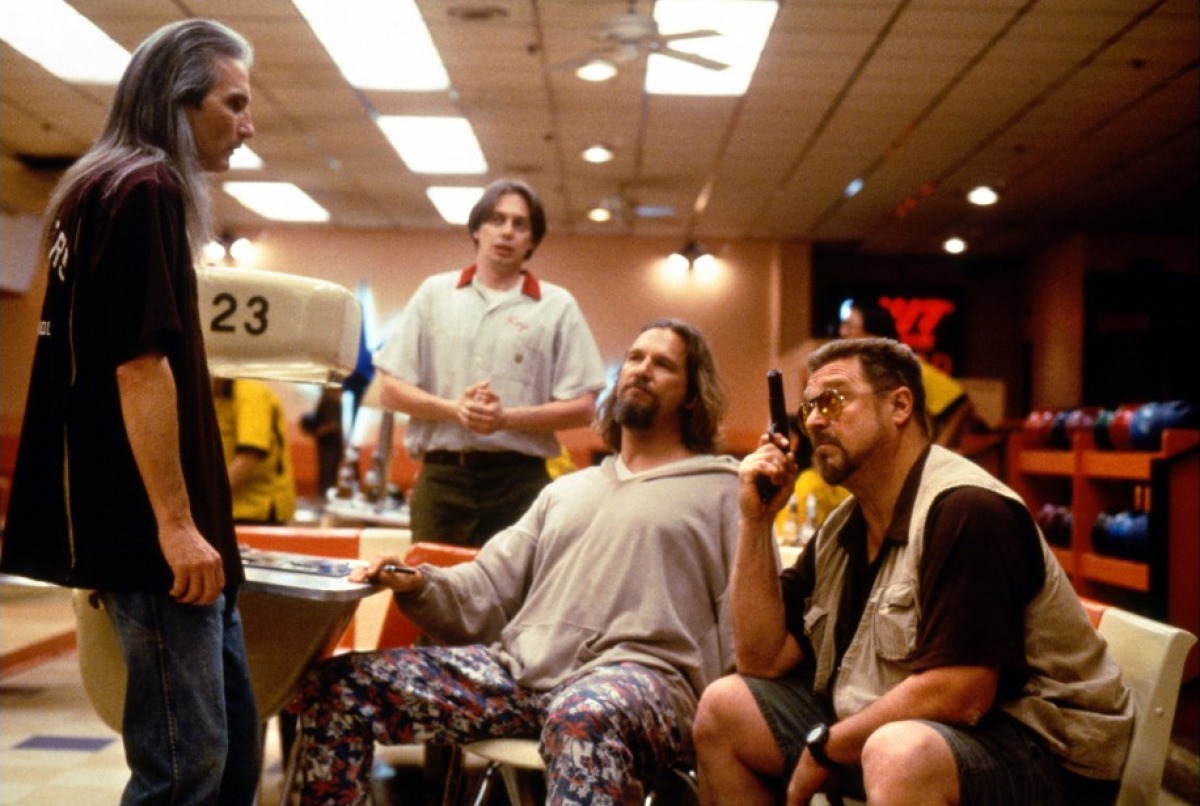17. Faster, Pussycat! Kill! Kill! (1965)
“Faster, Pussycat! Kill! Kill! is, beyond a doubt, the best movie ever made,” gushes John Waters, in his book Shock Value. “It’s possibly better than any film that will be made in the future,” he adds with 24-carat appraisal. Featuring a full compliment of sadistic-yet-seductive go-go dancers, gratuitous violence, double entendres and innuendo-addled dialogue, this is Russ Meyer exploitation territory, make no mistake.
The Mojave Desert adds exotic appeal to the outlandish goings on, magnifying a comic book feel, as do strange and heroic angles, quick-cutting, and a delirious clip, making for a most singular viewing experience. The unholy trinity of go-go dancers, who drag race through the dunes in a souped-up Porsche, are led by Varla (the scene-stealing Tura Satana), sheathed in black leather, buxom, and brutal, her garish makeup underscores she’s seriously badass.
Faster, Pussycat! has improved with age, as an offbeat social artifact, an early, aberrant feminist fable, and as a speedy ride, wild beyond doubt. It’s a riotous underground masterpiece and Meyer’s magnum opus.
16. Pee-Wee’s Big Adventure (1985)
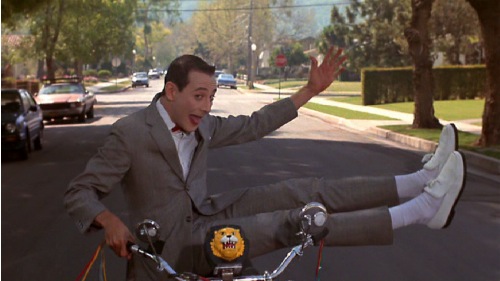
Impressed by his strange stage show at the Groundlings theater, Warner Brothers contracted Paul Ruebens to write a feature based around his quirky, child-like überbrat persona, Pee-Wee Herman.
Inspired, strange as it sounds, by Italian neo-realist innovator Vittorio De Sica (specifically his celebrated film, The Bicycle Thief), Reubens wrote one honey of a nonconformist comedy and found the ideal director, a former Disney animator looking to leap into a live-action feature, Tim Burton.
Together Burton and Reubens combined Dalí-like surrealism into a live-action cartoon that would anticipate the long-running subversive Saturday morning kids show, Pee-Wee’s Playhouse (1986-1990), a sequel, Big Top Pee-Wee (1988), and introduce Tim Burton to the world at large.With great gags, overflowing quotable quips, no wonder audiences ate it up, and no one’s been able to listen to the Latin-flavored “Tequila” and NOT dance like Pee-Wee ever since.
15. Phantom of the Paradise (1974)
As stylishly excessive as any Brian De Palma film, Phantom of the Paradise, a midnight movie musical version of Faust, is a feast for the senses. A playful piss-take on pop music—like Paul Williams’ Swan, an impresario à la Phil Spector—De Palma beat The Rocky Horror Picture Show to the ball by a heavy year and a half.William Finley’s glammed-out and disfigured Phantom (aka shock-rocker Marilyn Manson’s fashion template), gives a great performance, but the real hero is De Palma’s direction.
All of his signature camera flourishes are here; slo-mo, split-screen, dizzying tracking shots, split focus diopters, and virtuoso long-takes. A precursor to the modern music video and exemplar of late-night liturgy (especially in wintry Winnipeg, Canada, where the film inexplicably found its most rabid admirers), Phantom of the Paradise is a glowing after dark delight.
14. Halloween (1978)
Few films have left such a lasting mark on the genre as the 1978 horror classic Halloween. John Carpenter and Debra Hill wrote the script in a scant two weeks and shot it quickly, on a shoestring $325,000 (it would gross $100 million, becoming a massive indie success).
A bare-bones plot about mental patient escapee Michael Meyers (Nick Castles), would provide the stencil for scores of slasher film imitators to follow, and a then unknown Jamie Lee Curtis would soon be dubbed “scream queen” and become an international star.Carpenter, using a simplistic subjective camera, and a startling soundtrack—itself an homage to Goblin, Dario Argento’s band du jour for his similarly impressive horror incursions—would stir untarnished shock value and terrible anxiety for decades to follow.
13. Kiss Me Deadly (1955)
A hard-boiled thriller with a startling visual style, Kiss Me Deadly, adapted from a Mike Hammer private-eye paperback by Mickey Spillane, would become director Robert Aldrich’s finest film. Released at the height of the Red Scare in the mid-50s, American critics couldn’t connect with all the strangeness onscreen. François Truffaut, then writing for Cahiers du Cinéma, espoused his approval at once, “there can be no doubt that the revelation of Robert Aldrich will be the cinema event of 1955.”
A convoluted plot involving a glowing, radioactive briefcase—a classic MacGuffin paid homage in films like Raiders of the Lost Ark, Repo Man, and Pulp Fiction—femme fatales at every turn, and macho male posturing, Kiss Me Deadly offers audiences a mind-boggling mystery amidst a crime-addled LA-underbelly. In terms of film noir, it’s a twenty-first century monument with a short-fuse.
12. Eraserhead (1977)
There’s probably no director alive today that epitomizes the essence of cult filmmaker like David Lynch. But before Missoula, Montana’s favorite son gave the world the Twin Peaks phenomenon, or the neo-noir nightmare of Blue Velvet, amongst others, Lynch gave us an abrasive, surrealist fantasia called Eraserhead.
Shot over an exhaustive six year period, it’s a crazy-quilt charcoal comedy, obsessed with body horror and starring Lynch’s greatest muse, Jack Nance. Miserable factory worker Henry (Nance) toils in an industrial wasteland when one day his girlfriend, Mary X (Charlotte Stewart), informs him he’s the father of a repulsive mutant child.
In terrifically textured black-and-white imagery and unsettling soundscapes, the term “Lynchian” entered the lexicon. Eraserhead, due to its disturbing imagery, and inherent eccentricity, is an acquired taste, but it’s also an enduring chef-d’oeuvre, and a great midnight movie.
11. Suspiria (1977)
An unassailable sensory experience, Suspiria is a shocking and stylish giallo picture from Italian auteur Dario Argento. This spine-chilling 1977 masterpiece is an all out Technicolor nightmare with deliberate fairy-tale allusion, psychoanalytical themes, and relentless terror.Jessica Harper is Suzy Bannion, a new student at an embellished European ballet academy that secretly houses a coven of ferocious witches, administered by the mysterious Mother Suspiriorum (Lela Svasta).
Just as stunning as the cinematography—which references such old hands as Hitchcock and Antonioni—is the exciting and unrelenting musical score by prog rock legends Goblin, combining to make a pop culture touchstone where horror, exploitation and arthouse intersect.
10. Monty Python and the Holy Grail (1975)
Is there a more quotable comedy than the side-splitting, pants-pissing, so-funny-it-hurts tour de force, Monty Python and the Holy Grail? Considered to be the British troupe’s first film proper—their portmanteau picture four years before, And Now for Something Completely Different, was comprised of sketches previously seen on their Flying Circus television show—the Holy Grail soared to cult status celebrity almost as soon as it opened in theaters in 1975.
Meta-comedies existed before—like Woody Allen’s Sleeper and Mel Brooks’ Blazing Saddles—but the Pythons gleefully rushed the gate with their absurdist brand of intertextual parody. Its an intelligent celluloid animal; there’s social commentary in the mode of the Marx Brothers, even Hieronymus Bosch (“bring out your dead”), and it’s so densely packed with gags that a single viewing can’t reveal them all.
Hence the ritualised repeat-viewing audience, ready to sing and shout along in ultra-clever faux English accent (or preposterous French iteration when doing the taunters). A classic comedy, as absurd as it is uproarious.
9. The Big Lebowski (1998)
“I’m the Dude,” explains the titular unemployed layabout, in the Coen brother’s most idiosyncratic shaggy-dog. “So that’s what you call me. You know, that or, His Dudeness, or Duder, or El Duderino, if you’re not into the whole brevity thing.”As the Dude in question, Jeff Bridges will be forever identified as the personable pothead, who’s Raymond Chandler inspired exploration to nowhere (The Big Lebowski rubric is a reference to The Big Sleep) has spawned one of the most fervid fanbases around.
Lebowski Fest occurs in cities across North America, alongside regular screenings where attendees dress as their favorite characters, spout quick-fire exchanges, sip White Russians, and identify 100% with the fragmented narrative. Maybe Lebowski isn’t for everyone, but don’t harsh the mellow if it’s not, “because, like, that’s just your opinion, man.”
